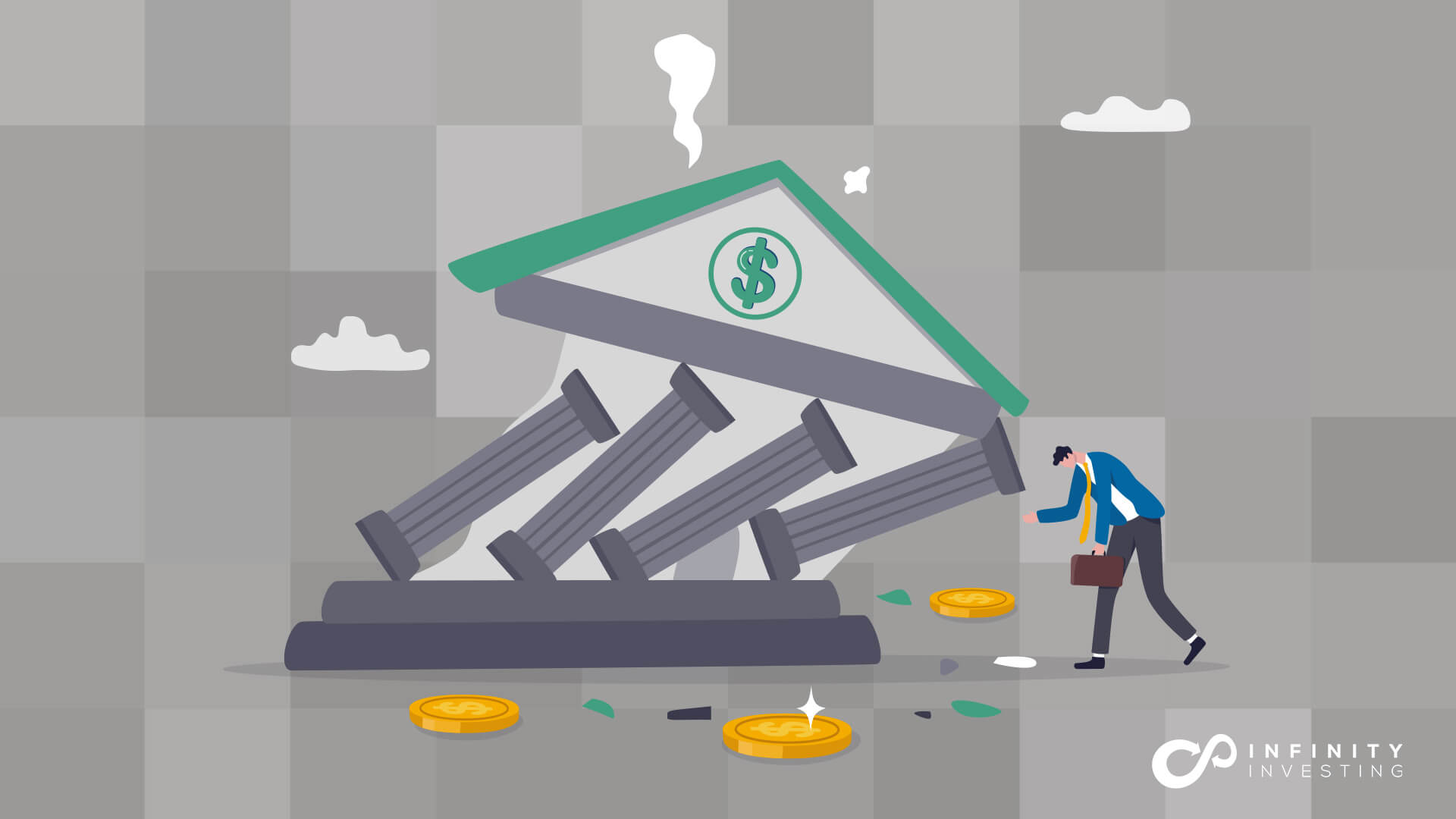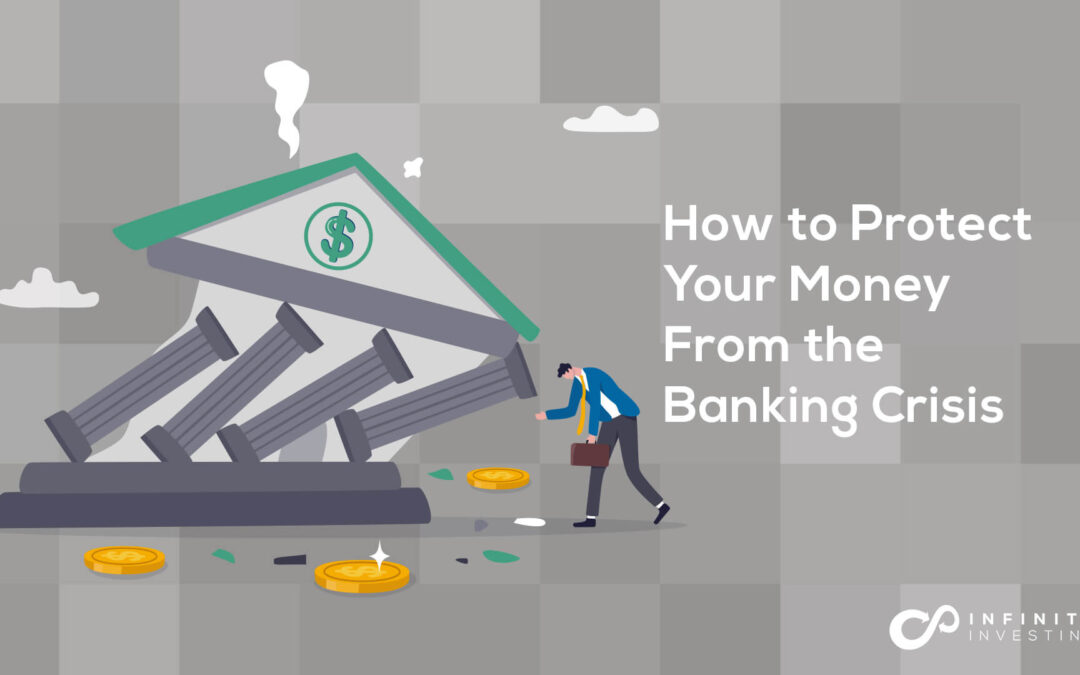
Many Americans question the safety of the United States’ banking system after the recent collapse of some of its biggest institutions. After this collapse, now called the U.S. banking crisis, multiple banks were seized and sold by the federal government because of their inability to fulfill withdrawal requests. The banking collapse may have left you questioning what happened and seeking the best way to protect your money.
Despite reassurances from the government and regulatory authorities, the second biggest banking collapse occurred slightly over a month later, making creating an asset protection strategy even more essential. This guide briefly overviews the events leading to the recent banking crisis and a few strategies to keep your money safe.
Key Takeaways
- The banking emergency began with the collapse of Silicon Valley Bank (SVB) in March 2023.
- Smaller bank failures, including Signature Bank, also contributed to the banking crisis.
- The most recent banking crisis victim was First Republic Bank in May 2023.
- Extending your insurance coverage by distributing your money across different accounts or banks is a wise move to protect your wealth.
- Checking bank ratings can help you choose the safest banks.
- Banks are generally a safe place to invest your money if you choose those insured by the Federal Deposit Insurance Corporation (FDIC) and Securities Investor Protection Corporation (SIPC).
Infinity Investing Featured Event
In this FREE event you’ll discover how the top 1% use little-known “compounders” to grow & protect their reserves. Our Infinity team of experts show you how to be the best possible steward of your finances and how to make your money and investments work for you instead of you working for them. Regardless of your financial situation today, you’ll have a road map to get to where you want to be.
What Is the Banking Crisis?
The banking crisis refers to a series of bank failures that led to a generalized mistrust of banking institutions. The first bank to collapse was SVB. Banks typically use deposits to purchase long-term bond investments to increase their earnings. SVB purchased substantial long-term bonds that were greatly affected by interest rates.
With interest rates reaching record highs, the value of long-term bonds significantly declined. While SVB attempted to offload some of these bonds, they were now worth much less than their initial purchase price, leading to high losses. Consumers recognized the losses and began urgently withdrawing their money. Eventually, SVB no longer had enough funds to fulfill withdrawal requests, leading to the California Department of Financial Protection and Innovation shutting them down.
The collapse of Signature Bank followed shortly after SVB, with federal regulators closing the bank after it couldn’t meet consumer withdrawal requests. As a result, Signature Bank was sold to Flagstar Bank. Other smaller banks followed, including Silvergate, a California-based institution. Stocks of regional banks and Credit Suisse dropped significantly.
In early March, the U.S. Department of Treasury, the FDIC, and the Federal Reserve assured Americans that they’d take a united approach to keep a strong U.S. banking system. Despite these assurances, another bank was seized and sold a little over a month later.
First Republic Bank is the latest institution to succumb to the U.S. banking crisis. On May 1, 2023, the U.S. government seized First Republic Bank and sold it to JPMorgan Chase. However, First Republic Bank’s problems go back to March when 11 U.S. banks directed over $30 billion into the institution to keep it afloat. Yet, First Republic stocks continued decreasing, and it considered selling portions to recoup funds.
By the end of April 2023, First Republic reported a loss of over $100 billion, including the funds it had received from other banks. The bank released a plan to overcome its losses using layoffs and executive salary cuts, but First Republic stocks continued to decrease until seizure by the FDIC.
How to Protect Your Money From the Banking Crisis
Regular news reports about failing banks may make you uneasy about entrusting your money to them. It’s important to note that fluctuating interest rates and inflation are standard parts of the U.S. economy. The banking system is generally considered safe if you choose insured banks and stay within insurance limits. Here are a few tips to protect your money during a banking collapse.
Choose Insured Banks
Choosing insured banks is essential in protecting your funds. There are three insurance types: FDIC, SIPC, and private insurance. The FDIC protects some financial institutions and investors’ funds up to $250,000. The SIPC protects brokerage and custodial firm investments up to $500,000.
Some investment brokerages and custodial accounts carry their own private insurance policies, covering investors up to $150 million. If you have over $250,000 to deposit in a bank, divide your money into multiple accounts for greater protection. Some investors may even prefer diversifying their money across different banks to help manage risk.
Diversify Your Investments
Another strategy to protect your assets is to move your funds during volatile banking times, such as the banking crisis. Many people moved their funds to money markets after the initial collapse of SVB. Certificates of deposit (CDs) are another popular investment option. CDs typically carry less risk than other investment types such as stocks or bonds. You might also choose to invest in U.S. Government bonds or index funds. Selecting safer investments may be especially important if you’re near retirement age.
You may also diversify your risk by choosing other investment types entirely. Investing in real estate offers many benefits, such as passive income, high investment returns, and the opportunity to use equity as leverage for additional investments. You also have many investment diversification options within real estate, comprising short-term rentals, long-term residential rentals, and vacation properties.

Choose the Right Bank Accounts
In addition to different bank sizes, knowing the difference between a bank and a custodian account is helpful. Banks use investors’ deposits to earn returns through investing. Some banks may reward investors with a small percentage of interest for borrowing the funds. A custodian account differs from a bank account, keeping each investor’s account separate. Unlike a traditional bank account, custodian account providers can’t move your money without your explicit permission.
You’ll notice the biggest difference between a bank and a custodian account on your bank statement. When you receive a bank statement from a traditional banking institution, the amount listed is how much the bank owes you rather than what’s currently in your account. Since a custodian account manager can’t access your funds without permission, a custodian account statement shows how much is actually in your account. Custodian accounts are also more likely to have private insurance in addition to FDIC and SIPC.
Of course, while custodian accounts may offer many advantages over a traditional institution, they aren’t designed for daily use. You’ll still want to compare traditional banks to choose the safest option.
Check Bank Ratings
Check bank ratings when deciding how safe your investments or savings are with a specific institution. A few ratings to consider include BauerFinancial, Moody’s, and Standard & Poor’s. Moody’s, for example, downgraded SVB’s bond rating after it had a rough start to the year, indicating financial trouble for some.
Moody’s also downgraded the credit ratings for First Republic Bank in March to alert consumers of its illiquidity risk. You can also review each bank’s history, including how long it has been in business and whether it has recently accepted bailouts from the government or other financial institutions.
Balance Risk With Reward
As with any investment, balancing risk with reward is crucial. Smaller banks may be more willing to offer slightly higher interest rates but carry much more risk. Larger banking institutions in the U.S. reported exceptional first-quarter earnings, demonstrating that consumers are more likely to trust well-known brands during a banking failure. Larger banks with a proven track record are typically liquid, meaning they have the funds available when you want to withdraw.
Do Your Research
Researching, including checking bank ratings and knowing where your funds are going, is essential to protect your wealth. Work with a fiduciary, which is a financial specialist who helps you make important financial decisions. Laws require fiduciaries to guide you in investments or decisions based on your personal interests rather than their own.
A financial advisor can help you stay up to date on the latest banking downturn information and choose the safest, most profitable investments. Working with a financial advisor also allows you to evaluate your goals and choose investments that best help you meet them.
Learn More About Safe Investing During a Financial Crisis
The banking industry and general economy constantly fluctuate, sometimes making it difficult to choose the best and safest investments. Sign up for a 360 Pro membership today to access investing tips and tricks, including asset protection strategies. The two keys to building financial wealth are creating a strategy that earns returns and ensuring you put the proper safety perimeters in place to protect your money. A 360 Pro membership gives you access to value-packed workshops, educational videos, and a close community to help you navigate complex financial times like the U.S. banking crisis.
Infinity Investing Featured Event
In this FREE event you’ll discover how the top 1% use little-known “compounders” to grow & protect their reserves. Our Infinity team of experts show you how to be the best possible steward of your finances and how to make your money and investments work for you instead of you working for them. Regardless of your financial situation today, you’ll have a road map to get to where you want to be.

